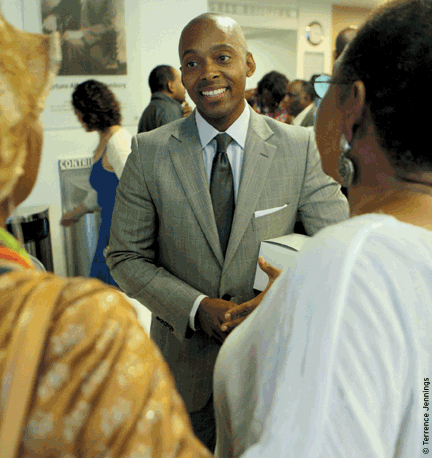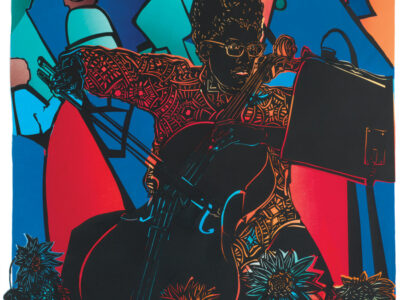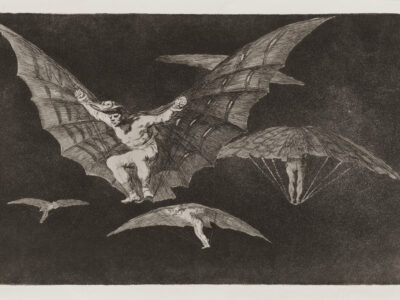
Class of ’93 | As Khalil Gibran Muhammad C’93 addressed the crowd gathered for the debut of the Romare Bearden exhibition at the New York Public Library’s Schomburg Center for Research in Black Culture, he pointed to one special lithograph: a commemorative work commissioned on the 30th anniversary of the 1954 Brown v. Board of Education Supreme Court decision.
“It’s my favorite,” says Muhammad, the center’s new director, “because it’s etched into thousands of images connected with my commitment to social justice, education, and parenting; the print hangs in my oldest son Gibran’s room.”
Since his post-Penn years teaching public-school children at Bradford Academy in Montclair, New Jersey, and later while earning his PhD in history at Rutgers, Muhammad has used his scholarly acumen and instructional instincts to fight societal wrongs and prepare young people for a not-yet-color-blind world. But it wasn’t until 2003, when his preliminary doctoral research revealed a need for scholarship about black crime in Northern cities during the Progressive era, that Muhammad narrowed his scope to crime and racism.
This recasting took him first to New York’s Vera Institute of Justice, where he was a Mellon Postdoctoral Fellow on Race, Crime, and Justice, and then to the Harlem-based Schomburg Center, which is named after Puerto Rican historian and activist Arturo Alfonso Schomburg. The latter’s rich collection of papers of social-service organizations “whose activities intersected with the criminal-justice system” proved invaluable to Muhammad in writing his first book—The Condemnation of Blackness: Race, Crime and the Making of Modern Urban America (Harvard University Press, 2010)—which earned its author a 2010 prize from the American Studies Association.
The book describes how sociologist Ira De A. Reid examined “whether the surge in police action in the North was a function of what [black] people in the community were doing or something else,” says Muhammad. “Statistics for European immigrants were pretty grim, but if you held [everything] constant, the immigrants were not pathologized; they were humanized.” In other words, white urban populations stigmatized blacks upon the release of the 1890 census and crime statistics, but used similar statistics about European immigrants to “demonstrate that [group’s] assimilability.”
After earning his PhD from Rutgers in 2004, Muhammad entered the academy as an assistant professor of American history at Indiana University. By July 2011, by which time he was a full professor, he officially took over the directorship of the 85-year-old Schomburg Center, and his experience on “both sides of the desk” spurred him to rebrand it as a “national destination” for black literacy. Here, budget permitting, some of the papers of Rosa Parks and other civil-rights figures of the 1960s will be archived, along with recent acquisitions from poet Maya Angelou. Muhammad’s agenda also includes “teach-ins inspired by 1960s civil-rights activists, after-school workshops, a youth council, and black-history exhibitions drawing from the visual and performing arts.”
Muhammad, whose forthcoming book is titled Disappearing Acts: The End of White Criminality in the Age of Jim Crow, expects that these forums will encourage dialogues on racism, black incarceration, and other hot topics.
“We only talk about [things like slavery] in carefully veiled language—the opposite of how we treat the Holocaust—even though both show the capacity of man to destroy another” people, he says.
This apathy regarding black history is the opposite of the environment in which Muhammad grew up in South Chicago. His middle-class parents taught him black culture, although he adds that he and his father, New York Times photo-journalist Ozier Muhammad, “did not have seminal conversations about race, or trade questions and answers about my great-grandfather Elijah Muhammad,” a founder of the Black Muslim movement and leader of the Nation of Islam from 1933 until his death in 1975.
Today, as conservator of the Schomburg’s collection of some 10 million catalogued items and as supervisor of 55 employees, Muhammad combines aggressive public relations and fund-raising programs to augment a $6 million budget. He uses local and national keynote speeches and panel discussions to advance his goals and make some larger points about society.
Muhammad believes the Schomburg can be a venue for envisioning a post-racial society as well as debating such matters as fairness in the criminal-justice system, racial profiling, and Confederate History Month. Having noted upon being named director that the center can play a “crucial role in moving Black history from the margins to the center of American public discourse,” Muhammad adds: “People must learn about the past so they can be smart about the present, before reality smacks them in the face.”
— Janice Arenofsky




